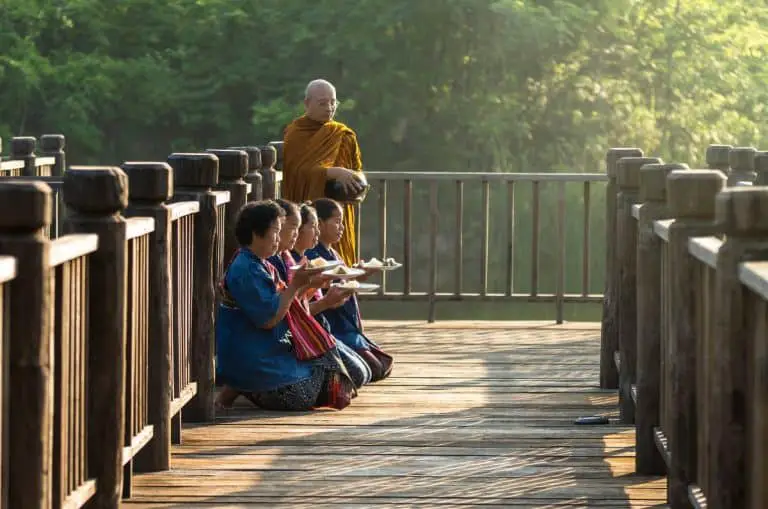Navigating Thailand: A Woman Traveler’s Handbook
Golden temples, bustling markets, pristine beaches, and a rich tapestry of history and culture—Thailand is a dream destination for many. But for women travelers, navigating a new country can come with its own set of challenges and curiosities. Whether you’re a solo adventurer or traveling with companions, understanding Thailand’s unique cultural nuances can make all the difference in your journey.
In this guide, we’ll delve into essential tips tailored for women, ensuring that your Thai adventure is not only memorable but also safe, respectful, and truly enriching. Dive in and prepare to embrace the Land of Smiles with confidence and grace.
Prioritize safety in solo travels. Respect cultural dress codes, especially at temples. Learn basic Thai phrases. Bargain gently in markets. Opt for reputable transport. Stay hydrated, and avoid tap water. Engage authentically with locals. Embrace group tours for camaraderie.
Key Takeaways
- Understanding and respecting Thai culture, especially in terms of dress code and interactions, is crucial for a positive travel experience.
- While Thailand is generally safe, women travelers should take certain precautions, especially when traveling solo or at night.
- Embrace local experiences, learn basic Thai phrases, and connect with locals to enrich your journey and create lasting memories.

Understanding Thai Culture
Thailand, often referred to as the “Land of Smiles”, is a vibrant tapestry of traditions, beliefs, and customs, deeply rooted in its rich history. One cannot traverse the bustling streets of Bangkok or the serene pathways of Chiang Mai without feeling the pulse of its cultural heartbeat.
Significance of Religion and Temples
At the very core of Thai culture lies its profound reverence for religion, predominantly Buddhism. Approximately 95% of Thais practice Theravada Buddhism, making it more than just a religion; it’s a way of life. The country is dotted with over 40,000 temples, each a testament to its spiritual significance. These temples, locally known as ‘wats’, are not just architectural marvels with their shimmering stupas and intricate carvings, but they also serve as community centers where locals gather for ceremonies, education, and festivals. For instance, the Wat Phra Kaew in Bangkok, home to the revered Emerald Buddha, isn’t just a tourist attraction; it’s a sacred space where you can witness devotees offering prayers, lighting incense, and seeking spiritual solace.
Traditional Views on Women and Dress Codes
Navigating the cultural landscape of Thailand also means understanding its traditional views, especially concerning women and attire. Historically, Thai society has been patriarchal, but it’s essential to note that women have always played significant roles, be it in the realm of family or even as revered leaders like Queen Sirikit. However, with deep-rooted traditions come certain expectations regarding decorum and dress.
Dress codes, especially in religious sites, are a reflection of respect. For women, this often means covering the shoulders and wearing skirts or pants that go below the knees. Imagine you’re about to enter the Grand Palace in Bangkok; while the tropical heat might tempt you to don shorts and a tank top, a more appropriate choice would be a lightweight long skirt paired with a modest top. Many temples offer sarongs or cover-ups for visitors who might be unaware of the dress code, but it’s always a good gesture to come prepared. This isn’t just about adhering to rules; it’s about showing respect for a culture that values modesty and tradition.
Safety Tips
Thailand, with its welcoming locals and diverse landscapes, is a haven for travelers. However, like any other destination, it’s essential to prioritize safety to ensure a hassle-free experience, especially for women. Here are some tailored safety tips to keep in mind during your Thai adventure.
Traveling During the Day vs. Night
Thailand’s vibrant street markets, night bazaars, and full moon parties can be incredibly enticing, making nighttime explorations a must. However, there’s a distinct difference between wandering the well-lit streets of a bustling market and navigating dimly lit alleyways or remote areas.
During the day, cities and tourist spots are alive with activity, making it generally safer and easier to seek help if needed. If you’re exploring solo, it’s advisable to do most of your wandering during daylight hours. However, if the allure of the night is too strong to resist, consider joining group tours or traveling with companions. For instance, while the midnight tuk-tuk rides in Bangkok can be thrilling, ensure you’re using reputable services and always share your whereabouts with someone you trust.
Choosing Accommodations Wisely
Your choice of accommodation can significantly influence your travel experience. While Thailand offers a plethora of options, from luxurious resorts to budget hostels, it’s crucial to research before booking.
Always read reviews from fellow travelers, especially women, to gauge the safety and comfort of a place. Proximity to main roads, accessibility to public transport, and the presence of 24-hour front desk services can be indicators of a secure environment. For instance, a beach hut in Koh Samui might sound idyllic, but if it’s isolated from the main areas, it might not be the safest choice for a solo female traveler.
Staying Aware of Your Surroundings
Thailand’s sensory overload, with its myriad of sounds, sights, and scents, can be both enchanting and overwhelming. While it’s easy to get lost in the moment, maintaining situational awareness is paramount.
Always keep an eye on your belongings, especially in crowded areas like Bangkok’s Khao San Road or Chiang Mai’s Sunday Market. Be wary of overly friendly strangers or those offering deals that seem too good to be true. Familiarize yourself with common scams to avoid potential pitfalls. For example, if a random local informs you that a major tourist site is closed for the day (when it’s not), they might be trying to divert you to a more expensive alternative.
In essence, while Thailand is a relatively safe destination, adopting a proactive approach to safety can make your journey smoother and more enjoyable. Trust your instincts, stay informed, and remember: a well-prepared traveler is a happy traveler.
Dress Code and Etiquette
Thailand, with its rich cultural tapestry and diverse landscapes, is a treasure trove for travelers. However, to truly immerse oneself in its beauty and traditions, understanding the local dress code and etiquette is paramount. This is especially true for women, as attire can significantly influence interactions and experiences.
Appropriate Attire for Temples and Religious Sites
Temples, or ‘wats’, are sacred spaces in Thailand, and showing respect through appropriate attire is essential. When visiting these sites:
- Cover your shoulders and upper arms: Sleeveless tops, off-shoulder blouses, or tank tops are generally not suitable. Instead, opt for t-shirts, blouses, or even a lightweight scarf or shawl draped over your shoulders.
- Wear modest-length bottoms: Shorts, mini-skirts, or skimpy dresses are frowned upon. Choose knee-length (or longer) skirts, dresses, or pants. Traditional Thai ‘sarongs’ or ‘pha sins’ are also a popular choice among locals and tourists alike.
- Footwear: As a sign of respect, you’ll need to remove your shoes before entering temple premises. It’s a good idea to wear slip-on shoes or sandals for convenience. Also, ensure your feet are clean, as feet are considered the lowest part of the body in Thai culture.
Beachwear Guidelines
Thailand’s beaches are world-renowned, and while they’re more liberal spaces in terms of attire, some guidelines should be followed:
- Swimwear: Bikinis and one-pieces are acceptable on the beach or by the pool. However, once you leave the beach area or poolside, it’s respectful to cover up with a sarong, dress, or shorts and a top.
- Topless sunbathing: While some tourists indulge in this, it’s not widely accepted in Thai culture. It’s best to avoid it to respect local sensibilities.
Everyday Attire in Cities and Towns
Navigating through Thai cities and towns offers a blend of the traditional and the modern. Here’s what to keep in mind:
- Casual yet modest: Light, breathable fabrics like cotton are ideal due to the tropical climate. T-shirts, blouses, knee-length skirts, and pants are all great choices. While sleeveless tops are generally acceptable in cities, it’s a good idea to carry a scarf or a shawl, especially if you plan to visit a religious site.
- Footwear: Comfortable walking shoes or sandals are a must, given the amount of exploration you’ll likely be doing. In certain upscale establishments or government buildings, more formal attire and footwear might be required.
In conclusion, dressing appropriately in Thailand isn’t just about adhering to rules; it’s a gesture of respect towards a rich and diverse culture. By being mindful of your attire, you not only ensure smoother interactions but also enrich your travel experience by connecting more deeply with the local ethos.
Health and Wellness
Thailand, with its tantalizing flavors, tropical climate, and bustling cities, promises an unforgettable experience. However, to ensure that your memories are only of adventures and not ailments, it’s crucial to prioritize health and wellness during your journey. Here’s a guide to help you navigate the Thai landscape with vitality and vigor.
You’ve got to check out this article I wrote on Uncovering the Expat Communities in Thailand! It’s a treasure trove of valuable insights into the diverse areas of Thailand and what to anticipate when you make the move. Trust me, it’ll make your transition a whole lot smoother!
Local Cuisine and Foods to Try or Avoid
Thailand’s culinary landscape is a delightful dance of flavors, from the spicy kick of a ‘Tom Yum’ soup to the sweet embrace of ‘Mango Sticky Rice’. However, there are some guidelines to keep in mind:
- To Try: Dive into local specialties like ‘Pad Thai’, ‘Green Curry’, and ‘Som Tam’ (papaya salad). Street food in Thailand is a must-experience, with dishes like ‘Grilled Pork Skewers’ and ‘Coconut Pancakes’ being popular choices.
- To Avoid: Street food is delicious but opt for stalls that are busy (a sign of fresh produce) and where the food is cooked to order. Avoid pre-cooked dishes that have been sitting out for long periods, as they can be a breeding ground for bacteria.
- Raw Foods: Be cautious with raw salads and unpeeled fruits from street vendors. While they might look tempting, they could have been washed with tap water, which might not be safe for consumption.
Drinking Water and Staying Hydrated
The tropical climate of Thailand means you’ll be sweating more than usual, making hydration essential.
- Tap Water: It’s generally recommended to avoid drinking tap water. While it’s often chlorinated and safe for locals, foreign travelers might not be used to the local microbes, leading to stomach upsets.
- Bottled Water: Always opt for sealed bottled water for drinking. When buying, ensure the seal isn’t broken to avoid counterfeit bottles refilled with tap water.
- Rehydration: Given the heat and humidity, consider carrying oral rehydration salts or electrolyte solutions, especially if you’re indulging in strenuous activities.
Travel Insurance and Vaccinations
Ensuring you’re covered medically can make your trip worry-free.
- Travel Insurance: Opt for comprehensive travel insurance that covers medical emergencies, hospitalization, and even medical evacuation if needed. This is especially important if you’re planning activities like scuba diving or trekking.
- Vaccinations: While no specific vaccinations are mandatory for Thailand (unless you’re coming from a yellow fever-infected region), it’s wise to consider shots for Hepatitis A and B, Typhoid, and Tetanus. If you’re venturing into rural areas, consider getting vaccinated for Japanese Encephalitis and taking malaria prophylaxis. Always consult with a travel clinic or your physician before your trip.
In essence, while Thailand offers a sensory feast, it’s essential to be mindful of your health and well-being. By taking these precautions, you ensure that your Thai adventure is filled with joyous tales and not tales of tummy troubles or health hiccups. Safe travels!
Navigating Transportation
Thailand’s bustling streets, serene countryside, and everything in between make it a traveler’s paradise. However, getting from one place to another can be both an adventure and a challenge. Here’s a guide to help you navigate Thailand’s transportation landscape with ease and safety.
Using Local Tuk-Tuks, Taxis, and Public Transportation
- Tuk-Tuks: These iconic three-wheeled vehicles are a quintessential Thai experience. They’re great for short distances, especially in cities like Bangkok and Chiang Mai. However, always agree on a fare before starting your journey, as tuk-tuks don’t run on meters. It’s also a good idea to carry small change.
- Taxis: Most taxis in major cities are metered. Ensure the driver turns on the meter at the start of your ride. If they refuse, it’s best to find another taxi. Apps like Grab (Southeast Asia’s version of Uber) can also be handy, offering set prices and the safety of digital tracking.
- Public Transportation: Bangkok boasts an efficient BTS (Skytrain) and MRT (subway) system, which are safe and air-conditioned. There are also buses and songthaews (shared taxis) in various cities. Always keep an eye on your belongings in crowded places.
Safety Tips for Solo Travelers
- Share Your Route: If you’re traveling alone, it’s a good practice to share your route or destination with someone you trust, even if it’s a quick message to a friend or family member.
- Daytime Travel: Whenever possible, opt for travel during daylight hours, especially if you’re using public transportation or hailing a tuk-tuk or taxi from the street.
- Stay Alert: While Thai people are generally friendly and helpful, it’s essential to stay alert, especially in crowded areas. Be wary of unsolicited offers or overly persistent drivers.
- Negotiate Fares: Before hopping into a tuk-tuk or unmetered taxi, always negotiate and agree on a fare to avoid misunderstandings or being overcharged.
- Choose Reputable Services: If booking longer journeys, like buses or ferries to islands, always opt for reputable companies. Research reviews or ask fellow travelers or hotel staff for recommendations.
- Language Barrier: While many in the transportation sector speak basic English, especially in tourist areas, it’s a good idea to have your destination written in Thai. This can be especially helpful for taxi drivers or when navigating more remote areas.
Local Interactions
Thailand, often referred to as the “Land of Smiles,” is not just renowned for its scenic beauty and cultural landmarks, but also for its warm and welcoming people. Engaging with locals can transform a typical tourist experience into a memorable journey of genuine connections. Here’s how to navigate local interactions with grace and respect.
Building Rapport with Locals
- Smile and Show Respect: A smile goes a long way in Thailand. It’s a universal gesture that can break the ice and build instant rapport. Pair it with the traditional Thai greeting, the “wai” (placing your palms together near your chest and bowing slightly), and you’re sure to win hearts.
- Listen Actively: While there might be a language barrier, showing genuine interest and listening actively can foster deeper connections. Non-verbal cues, like nodding and maintaining eye contact, can convey your interest.
- Participate in Local Activities: Joining community events or workshops, like traditional cooking classes or craft sessions, can be a great way to interact with locals in a relaxed setting.
Learning Basic Thai Phrases
While many Thais in tourist areas speak English, learning a few basic phrases can make your interactions more meaningful:
- Hello: Sawasdee (with “ka” at the end for women, e.g., “Sawasdee ka” and “krub” for men)
- Thank you: Khop khun (again, “ka” for women and “krub” for men)
- Yes: Chai
- No: Mai
- Excuse me/Sorry: Khor thot
Understanding Local Customs and Gestures
- The Head is Sacred: In Thai culture, the head is considered the most sacred part of the body, while the feet are the lowest. Never touch someone’s head, and avoid pointing your feet at people or religious objects.
- Temple Etiquette: When entering temples, always remove your shoes. It’s also respectful to step over the threshold, not on it.
- Public Displays of Affection: While Thailand is quite liberal in many ways, it’s best to avoid overt public displays of affection, especially in rural areas. Holding hands is generally acceptable, but passionate gestures might be frowned upon.
- Monks: Women should avoid touching monks or handing things directly to them. If a woman needs to give something to a monk, it’s best to place the item down for the monk to pick up or hand it to a male intermediary.
In essence, local interactions in Thailand are a gateway to understanding the heart and soul of the country. By approaching these interactions with an open heart, a curious mind, and a respectful demeanor, you’ll not only enrich your travel experience but also create lasting memories and perhaps even lifelong friendships.
Shopping and Bargaining
Thailand’s bustling markets, intricate handicrafts, and myriad of shopping streets are a paradise for those looking to take home a piece of this beautiful country. However, to ensure you get the best deals and authentic experiences, it’s essential to master the art of shopping and bargaining in Thailand.
Tips for Bargaining in Local Markets
- Start Friendly: Begin negotiations with a smile. Thai culture values politeness, and a friendly demeanor can often lead to better prices.
- Quote Half: A common strategy is to start by offering half of the initial price. From there, you can negotiate to a middle ground that’s satisfactory for both parties.
- Walk Away Gracefully: If you feel the price isn’t right, it’s okay to walk away. Often, sellers might call you back with a better offer. However, do this gracefully without showing frustration.
- Buy in Bulk: If you’re purchasing multiple items, you have a better chance of getting a discount. Sellers are more likely to give you a deal if they’re making a larger sale.
- Stay Informed: Before diving into bargaining, familiarize yourself with average prices for common items. This can be done by observing or asking around in multiple stalls before making a purchase.
- Cash is King: Having small denominations of Thai Baht can make transactions smoother. Sellers appreciate exact change, and it can sometimes even get you a better deal.
Recognizing and Avoiding Tourist Traps
- Research Ahead: Before visiting popular shopping destinations, do a bit of research. Online forums, travel blogs, and guidebooks can provide insights into what to expect and which areas or shops might be overpriced.
- Beware of “Too Good to Be True” Deals: If a deal seems unbelievably good, approach with caution. It might be a low-quality product or even a counterfeit.
- Fixed Price Shops: While many markets in Thailand encourage bargaining, some shops have fixed prices. Respect these signs when you see them.
- Touts and Middlemen: Be wary of individuals who approach you with offers to take you to “special” shops or factories. These are often setups where they get a commission, and you might end up paying more.
- Gem Scams: Thailand is famous for its beautiful gemstones, but it’s also notorious for gem scams. Only buy from reputable dealers and avoid shops that claim to offer tax-free gems that you can sell for a higher price back home.
- Stay Calm and Enjoy the Experience: Remember, shopping in Thailand is as much about the experience as it is about the purchase. Engage with sellers, learn about their products, and enjoy the vibrant atmosphere.
Shopping in Thailand can be a delightful experience, filled with colorful products, aromatic spices, and the lively chatter of marketplaces. By staying informed and approaching the experience with an open mind and a bit of strategy, you can ensure that you get the best deals and authentic souvenirs to cherish for a lifetime.
Activities and Adventures
Thailand, with its diverse landscapes, rich history, and vibrant culture, offers a plethora of activities and adventures for every kind of traveler. For women, whether traveling solo or in groups, there’s a treasure trove of experiences waiting to be discovered.
Recommended Activities for Women Travelers
Temple Hopping: From the majestic Wat Phra Kaew in Bangkok to the mountain temple of Wat Phra That Doi Suthep in Chiang Mai, exploring Thailand’s temples is a spiritual and cultural journey.
Island Exploration: Dive into the crystal-clear waters of the Phi Phi Islands, sunbathe on the white sands of Koh Lipe, or explore the hidden lagoons of Koh Samui.
Thai Cooking Classes: Learn the art of Thai cuisine. Many cities, especially Chiang Mai, offer cooking classes where you can learn to make classics like Pad Thai or Green Curry.
Traditional Thai Massage: Experience the rejuvenating effects of a traditional Thai massage in its place of origin. Whether in a high-end spa or a local massage school, it’s a must-try.
Floating Markets: Visit markets like Damnoen Saduak or Amphawa, where vendors sell fresh produce, local dishes, and handicrafts from boats.
Trekking in the North: Explore the lush landscapes of Northern Thailand, visiting hill tribes and discovering hidden waterfalls.
Cultural Shows: Attend traditional dance and music performances, such as those at the Siam Niramit show in Bangkok.
Yoga and Wellness Retreats: Destinations like Koh Phangan and Pai are known for their wellness retreats, offering yoga, meditation, and detox programs.
Group Tours vs. Solo Adventures
Group Tours
- Pros: Safety in numbers, structured itineraries, and the chance to meet fellow travelers. Especially beneficial for first-time travelers or those on a tight schedule.
- Cons: Less flexibility, might be more expensive than solo travel, and the experience can be generic.
Solo Adventures
- Pros: Complete freedom to design your itinerary, deeper immersion in local culture, and the chance to make spontaneous decisions.
- Cons: Safety concerns, especially during nighttime or in remote areas. It might also feel lonely at times.
Tips for Solo Women Travelers
- Stay connected: Regularly update someone about your whereabouts.
- Trust your instincts: If something feels off, it probably is.
- Plan your day: Especially your return journey if you’re venturing out far.
- Join short group activities: Even if you’re traveling solo, joining a day tour or a group class can provide a sense of community.

Tips for Women Travellers in Thailand FAQs
Is it safe for a female to travel alone in Thailand?
Yes, reports generally indicate that Thailand is safe for solo female travelers. In fact, it’s often cited as one of the best countries for first-time solo travelers. As with any location, it’s important to take standard precautions and remain aware of your surroundings.
Is it safe for a female to travel alone in Bangkok?
Yes, Bangkok, as the metropolitan capital of Thailand, is generally considered safe for solo female travelers Nonetheless, practicing standard safety measures, especially at night and in crowded places, remains crucial.
What should I be careful of when visiting Thailand?
When visiting Thailand, travelers should take care to be respectful of local customs and regulations, particularly when visiting religious sites[. It’s important to dress modestly, particularly at temples and other religious sites. Safety precautions against common travel inconveniences, such as adequately hydrating and protecting against mosquito-borne illnesses, also come recommended.
Where is the best place to go in Thailand for a woman?
Thailand offers numerous beautiful locations for female travelers. These can range from the lively hustle and bustle of Bangkok, with its vibrant market scene and historic temples, to the serene landscapes of Chiang Rai or the breathtaking beaches of islands like Koh Samu Each location offers a unique experience depending on the traveler’s preferences.
Can I stay in a hotel with my girlfriend in Thailand?
Yes, unmarried couples can share a hotel room in Thailan. Most hotels will not have a problem with an unmarried couple sharing a room, though it’s always prudent to check ahead with a specific establishment just to be sure.
Conclusion
Thailand is a beautiful and diverse country that offers countless opportunities for discovery, adventure, and relaxation. Embracing the unique Thai culture, traditions, and practices, while keeping safety in mind, can significantly enhance a woman’s travel experience. As the Land of Smiles welcomes you, as a responsible and well-informed traveler, you are bound to create unforgettable memories.
Whether you’re a solo female traveler or journeying with your loved ones, understanding the nuances of the local customs and highlights will enable you to fully appreciate the beauty that Thailand has to offer. As you immerse yourself in the flavors, sights, and sounds of this vibrant nation, your experiences will be enriched, leaving you longing for more.
Subscribing to our newsletter will provide you with the best information, tips, and secrets to living and traveling in Thailand. Stay up-to-date with the latest news, and feel free to reach out to us with any questions you may have to make your journey even more rewarding. And remember, as you tread new paths in Thailand, embrace the hospitality and the kind smiles that adorn the faces of the locals. Happy travels!
Subscribe to our newsletter and make your Thailand experience remarkable!






